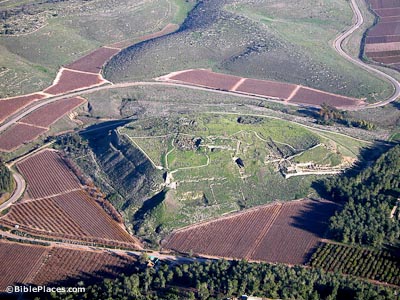Prof. Yosef Garfinkel states that current excavations at Tel Lachish have discovered a new, earlier entrance to the city on the northeast side of the tel. This is the opposite side of the mound from the known Iron Age gate.
People who have visited Tel Lachish will recognize the Iron Age gate in the photo below. It lies on the southwest side of the tel and was discovered in the 1930′s by Starkey and Tufnell. This gate and its approach ramp relate to the city levels destroyed by Sennacherib of Assyria in 701 BC and Nebuchadnezzar of Babylon in 587/6 BC.
Garfinkel believes the northeast section of the tel would have been a natural entrance point to the city in earlier times. The 2014 excavations exposed and clarified ancient fortifications in this area. Garfinkel gives the newly-discovered entrances a preliminary dating to the early Iron and Middle Bronze ages. (Biblically, this is the period ranging from the early kingdom years back to the Patriarchs.) The 2014 season at Lachish was cut short by the Israel-Hamas conflict, so these new entrances will be excavated in the 2015 season.
If this is in fact a gate that can be dated to the “early Iron Age,” then this is a very important discovery for reconstructing Israel/Judah’s geopolitical character in the 10th and 9th centuries BCE. Until now the fortifications (or lack thereof) of Lachish levels V-IV (generally dated to the 10th-9th centuries BCE) had remained an open question. Everyone agrees that Lachish level III (c. 760-701 BCE) is securely dated to the time of Hezekiah and Sennacherib based on the abundance of LMLK seal impressions, the siege ramp, the Nineveh reliefs and the biblical/extrabiblical texts that discuss the battle. This layer is followed by Level II that is characterized by another destruction of Nebuchadnezzar at the beginning of the 6th century BCE. This too, is well-accepted by everyone due to its clear connection with the biblical and extrabiblical sources (e.g. Lachish letters). But the periods between the well-dated Late Bronze levels (e.g. fosse temples, summit temple, etc.) and the 8th-6th centuries BCE (Iron IIB-C) were not nearly as well understood in either the First (Starkey) or Third (Ussishkin) major expeditions at the site.
Besides the very important ramifications related to the possible finding of the Middle Bronze Age gate (2000-1550 BCE), the possible finding of an Iron IIA gate at Lachish has the following ramifications upon the archaeology and history of Iron Age Israel/Judah:
- It would allow for a better synthesis with parallels of other currently excavated sites. For example, this is very significant for Tel Burna, the site that I excavate at, since we have a casemate fortification that dates at least to the late Iron IIA (9th century BCE) if not earlier (we have not reached the base of the wall yet). We have always thought that our site is under the direct control of Lachish during this period and now it seems that there may be a physical connection.
- It would make for a very important point of comparison of the fortifications and related finds at such sites as Tel Sheva, Arad, Tel Erani, Beth-Shemesh. This is also huge (!) for archaeological survey material, which has long used the sequencing at Lachish as the basis for dating ceramic finds at other sites (e.g. Yehuda Dagan – Shephelah Survey).
- It would show that early divided Judah or a united Israel was actively building in the Shephelah at the most important site in the region. This has major effects upon our interpretation on the nature of the massive city-state of Philistine Gath in relation to Judah, our reconstruction of Judah’s rise as a territorial state, and our overall understanding of the borders and hinterlands of Judah in the 10th-9th centuries BCE. To put this in perspective, here are 3 major articles that have been devoted to this topic in the last couple of years (e.g. Na’aman 2013, Sergi 2013 (and dissertation), Lehmann and Niemann 2014). Not to mention that my own dissertation will largely be devoted to addressing this very question.
- It would aid in determining the historical reliability of the Rehoboam fortification list of cities in 2 Chronicles 11:5-12, which includes the city of Lachish. Rehoboam lived in the late 10th century BCE, but this list is often dated to the time of Hezekiah, or even to the Hasmonean period (!) by Finkelstein.
 |
| Lachish from northwest – Iron IIB-C gates are on the right of the tell. New gate should be locate above the palatial podium (center of tell). |
7 thoughts on “New Gate Found at Lachish”
This guy has a remarkable ability to find gates.
I propose a new identification for the site since it has two gates: Shaarayaim.
🙂 Gerson Galil beat you to it on Facebook!
Good one!
We no doubt could have learned more if the current season wasn't cut short. Now to wait patently for a year (if not more) and see what comes out of the ground. An Iron Age gate would be nice for several reasons…
Dr. Gate-finkel strikes again! Seriously though, I haven't read Galil's FB page, but I'm guessing that the Qeiyafa gates were chronologically concurrent, whereas these Lachish gates were separated by centuries. Nonetheless, Todd & Gershon's comments were clever!
G.M. – We shall see… In the meantime it is fun to speculate 🙂
One more note: I do not believe the area under discussion (the NE corner) has been excavated since Starkey and Tufnell. I also understand they did not formally publish much of anything from this area. Considering there is a well and some significant architecture, these new excavations could fill in some important blanks in the city's history.
@ LukeChandler – thanks for the info! This should be very interesting – particularly since that would appear to also be a probable candidate for the water system…